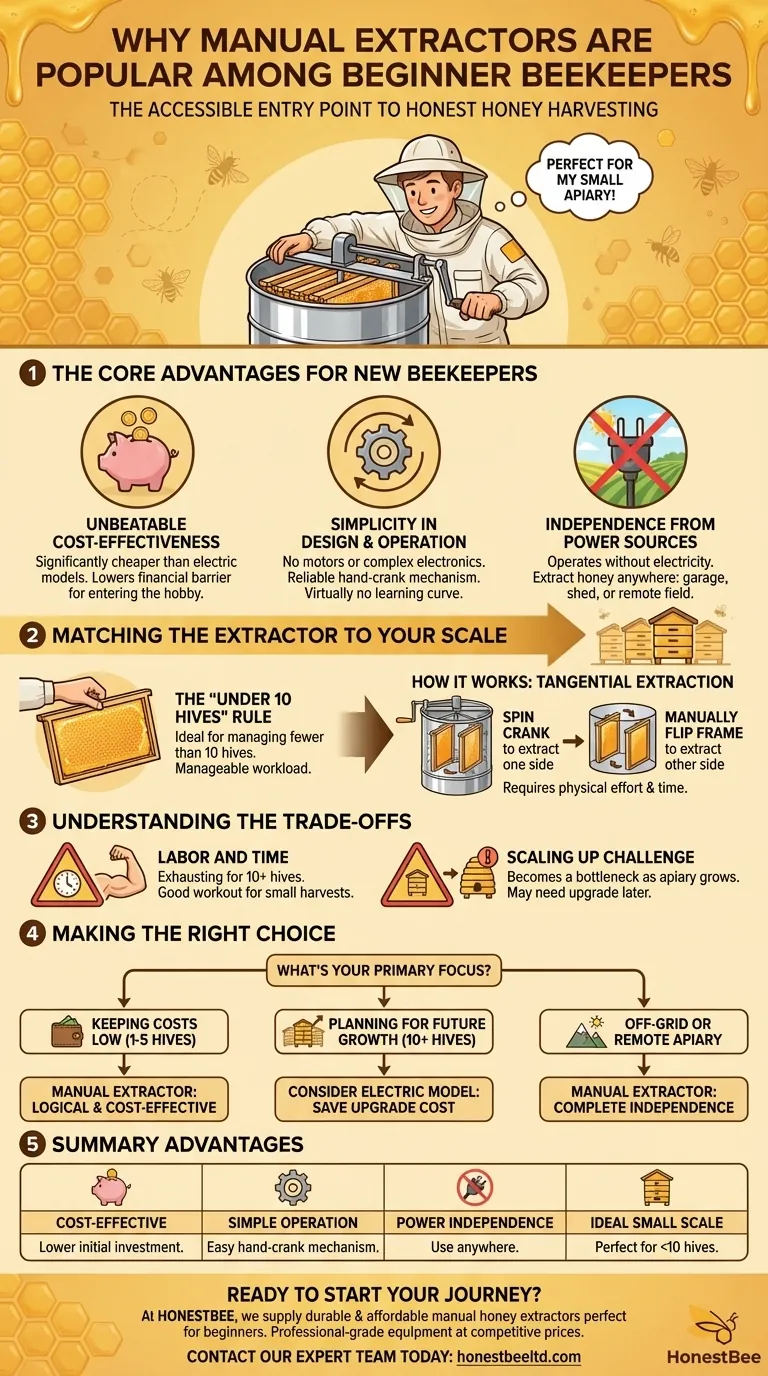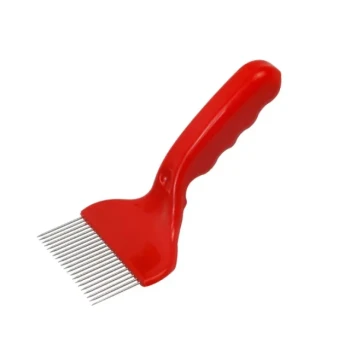At its core, a manual honey extractor is popular among beginners because it represents the most accessible entry point into honey harvesting. Its appeal is rooted in a combination of lower cost, operational simplicity, and independence from a power source, making it a practical choice for small-scale hobbyists.
The decision to start with a manual extractor is less about the equipment itself and more about matching your investment to the scale of your operation. It is the ideal tool for a new beekeeper managing a few hives, prioritizing affordability and simplicity over speed and volume.

The Core Advantages for New Beekeepers
When starting, beekeepers face numerous initial costs, from hives and bees to protective gear. The extractor is a significant purchase, and the manual option provides a sensible starting point.
Unbeatable Cost-Effectiveness
The most compelling reason for its popularity is the low price point. Manual extractors are significantly cheaper than their electric counterparts. This drastically reduces the financial barrier for someone just entering the hobby, allowing them to allocate funds to other essential equipment.
Simplicity in Design and Operation
A manual extractor works via a simple hand crank. There are no motors, complex wiring, or electronics to manage. This straightforward mechanism means there are fewer parts that can fail, making it reliable and easy to maintain. The learning curve is virtually nonexistent.
Independence from Power Sources
The ability to operate without electricity is a major advantage. This allows for honey extraction in a garage, shed, or even in the field, far from a reliable power outlet. It offers total flexibility in where and when you can process your honey harvest.
Matching the Extractor to Your Apiary's Scale
The suitability of a manual extractor is directly tied to the number of hives you manage. It is a tool designed for a specific scope of work.
The "Under 10 Hives" Rule of Thumb
Manual extractors are perfectly suited for beekeepers with fewer than 10 hives. With a small number of hives, the total number of frames to be extracted is manageable to process by hand in a reasonable amount of time.
How Manual Extraction Works
Most manual extractors are tangential, meaning the frames are placed with one side facing outward. You spin the crank to extract honey from the first side, then you must manually flip each frame to extract honey from the other. This process adds to the total labor involved.
The Physical Effort Involved
Operating a manual extractor requires physical effort. Cranking the handle to get the frames spinning fast enough can be a workout, especially when processing many frames or dealing with thick, crystalized honey.
Understanding the Trade-offs
While ideal for beginners, the manual extractor comes with clear limitations that are important to understand before purchasing.
The Primary Limitation: Labor and Time
The biggest trade-off is the investment of time and physical labor. For a small harvest of 1-3 hives, this is a pleasant afternoon's work. For 10 or more hives, it can become an exhausting, multi-day task.
Inconsistent Extraction Speeds
Maintaining a consistent, high speed with a hand crank can be difficult. Electric models spin at a steady, high RPM, which can extract honey more efficiently, especially if the honey is cool or viscous. A manual crank may leave more honey behind in the comb.
The Challenge of Scaling Up
If you plan to expand your apiary beyond a hobbyist scale, a manual extractor will quickly become a bottleneck. As your hive count grows, the time required for extraction will increase exponentially, making an upgrade to an electric model almost inevitable.
Making the Right Choice for Your Beekeeping Journey
Your decision should be based on your current needs and future ambitions as a beekeeper.
- If your primary focus is keeping costs low with 1-5 hives: A manual extractor is the most logical and cost-effective choice for your operation.
- If your primary focus is planning for future growth to 10+ hives: Consider investing in a small electric model from the start to save you the cost and effort of upgrading later.
- If your primary focus is an off-grid or remote apiary: The manual extractor is your best option, providing complete independence from electrical infrastructure.
Choosing the right extractor is about aligning your equipment with the current scale and future vision of your apiary.
Summary Table:
| Advantage | Description |
|---|---|
| Cost-Effectiveness | Significantly cheaper than electric models, lowering the initial investment. |
| Operational Simplicity | Simple hand-crank mechanism with no complex parts or electrical knowledge needed. |
| Power Independence | Can be used anywhere, as it does not require an electrical outlet. |
| Ideal for Small Scale | Perfectly suited for beekeepers managing fewer than 10 hives. |
Ready to start your beekeeping journey with the right equipment?
At HONESTBEE, we supply durable and affordable manual honey extractors and other essential beekeeping supplies perfect for hobbyists and beginners. Our wholesale-focused operations mean you get professional-grade equipment at competitive prices, whether you're a commercial apiary or a beekeeping equipment distributor.
Let us help you build your apiary for success. Contact our expert team today to discuss your needs and get a quote!
Visual Guide

Related Products
- Plastic Hand Crank 2 Frame Honey Extractor Low Price
- 6 Frame Manual Stainless Steel Honey Extractor Beekeeping Equipment
- 2 Frame Stainless Steel Manual Honey Spinner Extractor for Beekeeping
- HONESTBEE 3-Frame Manual Acrylic Honey Extractor
- Professional Durable Plastic Handle Honey Uncapping Fork
People Also Ask
- What are the advantages of manual honey extractors? Ideal for Hobbyist & Small-Scale Beekeepers
- How do you extract honey by hand? A Guide to Crush & Strain vs. Manual Extractor
- Can manual honey extractors effectively remove honey from cells? A Guide for Small-Scale Beekeepers
- What are the general precautions to take when extracting honey? Ensure a Safe, Efficient Harvest
- What makes polyurethane foam environmentally friendly? The Surprising Benefits of a Durable, Inert Material



















